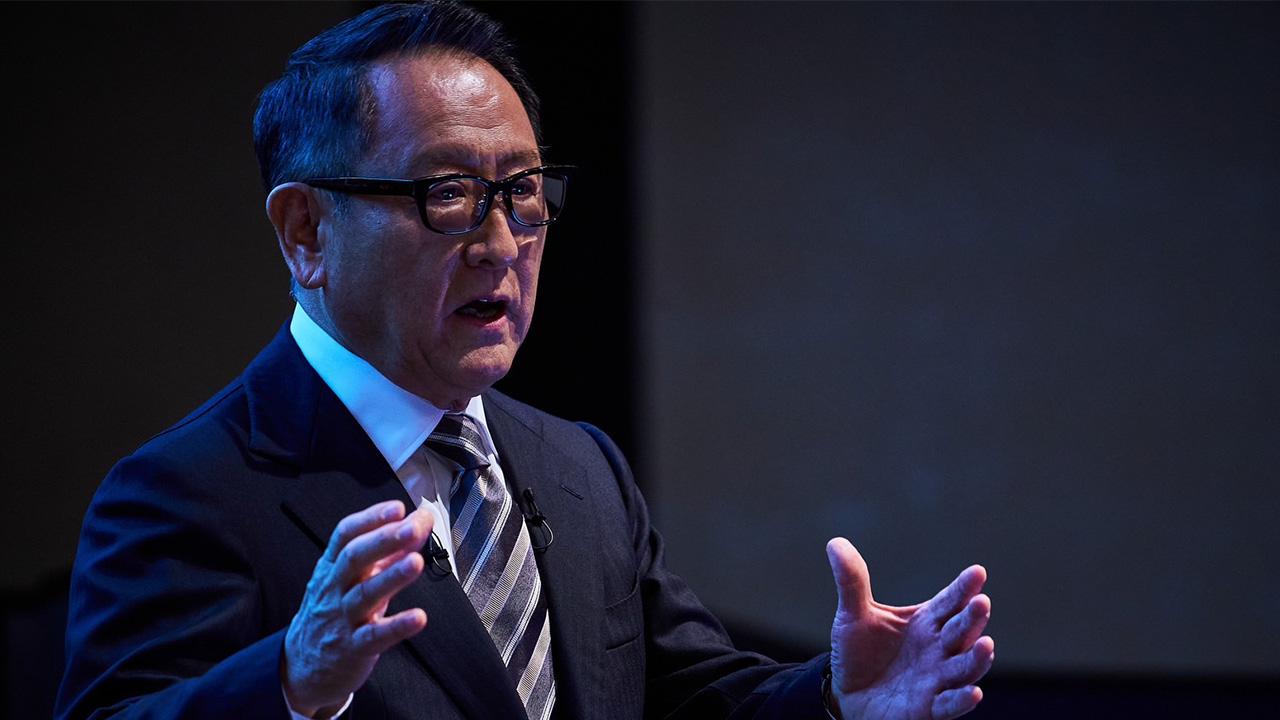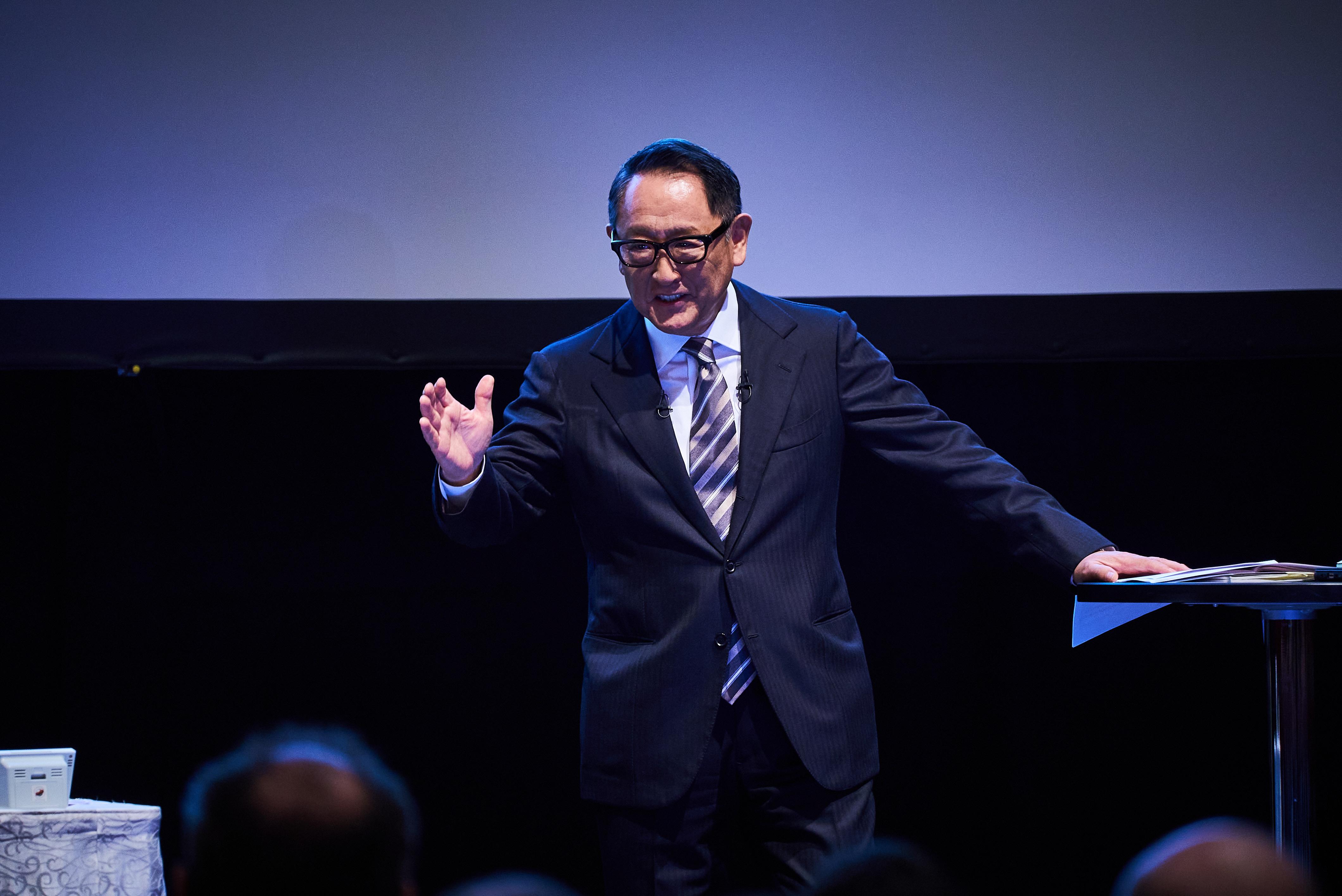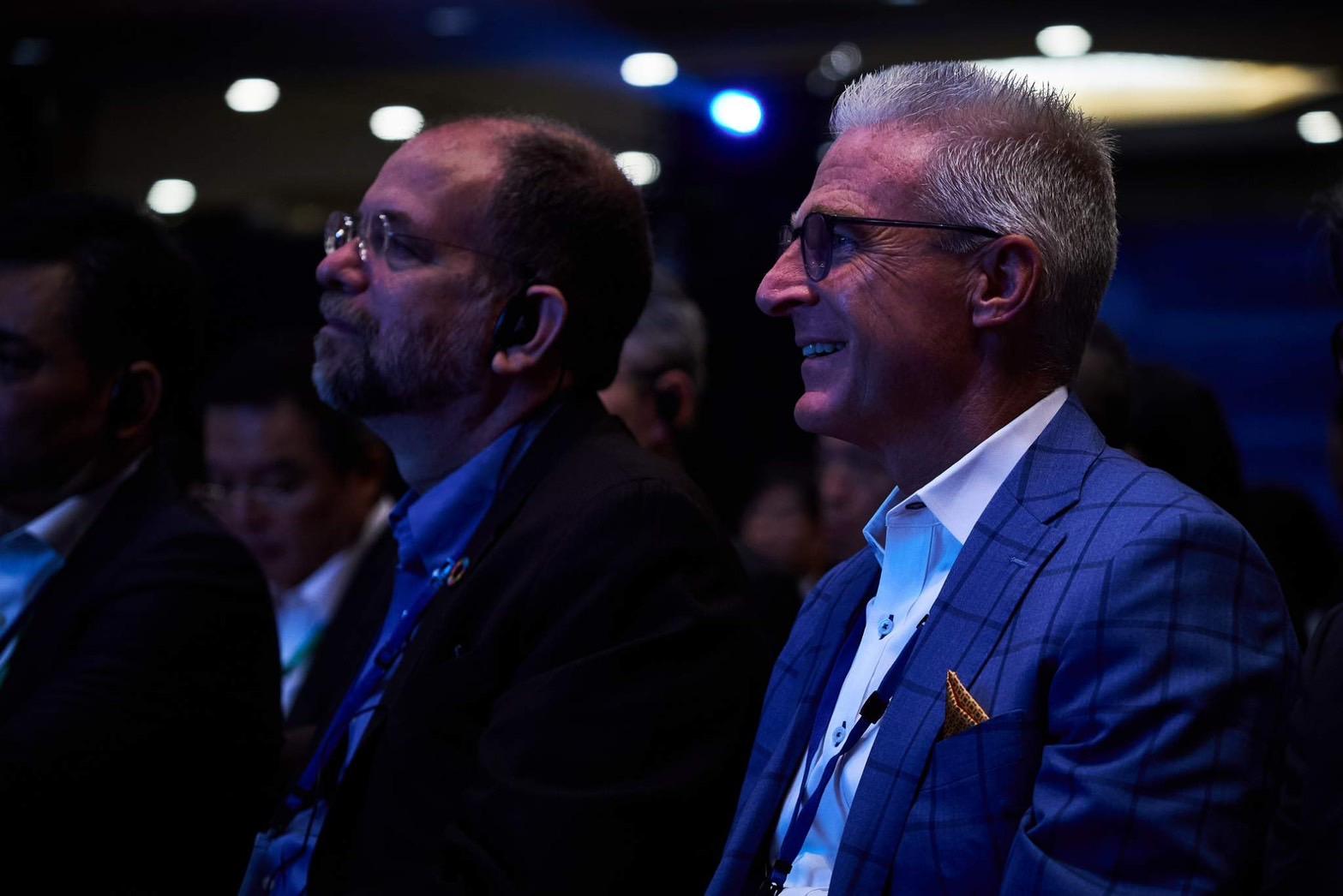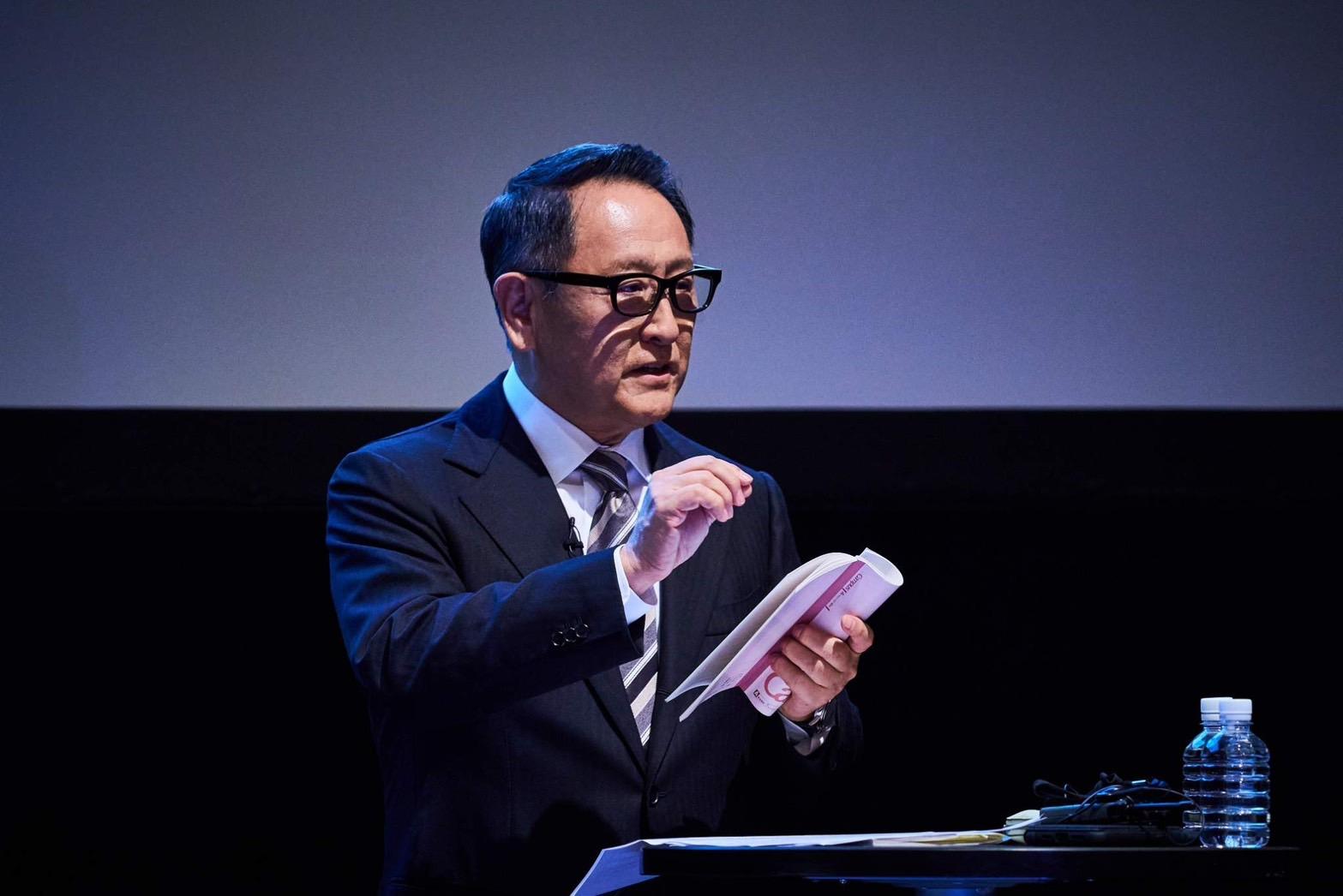
Akio Toyoda talks about his concerns and conduct during 14 years as president, along with what comes next.

Thud, thud, thud. Akio Toyoda’s footsteps reverberated through the hall as he ascended the stage. They sounded louder than usual, as though he was trying to convey something.
The venue was filled with overseas dealer representatives and other guests in the country for the JAPAN MOBILITY SHOW, who had gathered to hear Akio speak.
At the beginning of the session, several of the assembled members touched on topics from Toyoda’s presidency. Twenty minutes passed before Akio himself took the stage.
His footsteps finally rang out just as the emcee was about to keep the conversation going.
So began Akio Toyoda’s Juku.
“I’m not here today to reflect on the job that comes with the title ‘President of Toyota.’ Allow me to speak on for myself as an individual,” said a smiling Akio. With that, he started answering the 40 questions submitted by attendees.

I was always told I wasn’t up to the task.
Q1. You were the first Toyota president to present in English at an overseas dealer meeting. Why did you decide to become the face of the company?
When I attended the U.S. National Dealer Meeting as vice president, the executives coming from Japan were treated as guests. In reality, the dealers are the guests. It didn’t feel right that the Japanese higher-ups received such a welcome. After becoming president, I decided to work with Toyota America (North American distributor) to transform the event into an opportunity to express gratitude to our dealers.
Toyota dealers in the U.S. can trade their franchises. Moreover, some dealerships carry other brands, such as Ford and Chrysler, and those companies also hold dealer events. It started with me wanting to go on stage to convey my appreciation and ask for their support personally.
Naturally, I did it in English, but I was only able to do so with support from the people around me. One of those colleagues helped me to present who I am as an individual rather than Toyota’s president. I hoped to convey that while I may be Japanese, we eat the same foods and have the same interests. My English is not great, but people say it has a certain charm. I’m not terrible, but I am not a native speaker either. I think this not-so-great English worked to my advantage in winning people over.
That said, when I first became president in 2009, our poor performance and recall problems meant that all I did was offer apologies. As I visited various regions, the typical reaction was, “So you’ve finally come to apologize?” That was my role as president, but I hoped to turn apology into appreciation one day.
Q2. Off the record, could you tell us your favorite regions?
This answer is simple: the regions that care about our products and bring out many smiles.
I want to avoid places that only make demands, or simply tell me they have too many or too few cars (laughs). The areas that love our products and come out with smiles are a source of motivation.
Q3. How do you decide where you travel and who you meet?
This is tricky. I dislike places where the middle managers get a kick out of “bringing the chairman around” for the sake of internal functions.
The best places are those closest to our products and areas where dealers and genba employees are pleased to see me. All of you can rest easy (laughs).
Q4. You have regarded Africa and emerging regions in the same light as developed countries and always said that “no one will be left behind”—why is that?
When I became president, we had something called a global master plan (a mid- to long-term plan for sales volumes, market share, and revenue). The head office had plotted out how much would be allocated to which region.
To me, this felt disrespectful. In each region, we have people creating a base for the Toyota brand, engaging with customers every day to be the best in town.
By establishing a region-based structure and an in-house company system for different vehicles, we have ensured that any given region or car is someone’s top priority.
And then I am prepared to make overriding decisions, so I think it is fair, if not equal.
Rather than focus on how many vehicles are allocated, I want to reward people who are passionate and make an effort to convey the faces and needs of customers.
Q5. Through 14 years of “ever-better carmaking,” you brought out many captivating products. Since many people initially didn’t understand this approach, how did you get them on board, both inside and outside the company?
It took 14 years. My determination to make ever-better cars kicked into gear on the day in 2011 when we unveiled the Lexus GS in Pebble Beach, on America’s West Coast, only to be told that “Lexus is boring.”
In those days, we were doing test drives at Germany’s Nürburgring, where Toyota was the only company using an old car. The European carmakers running their upcoming development models looked at us and said, “Toyota can’t do it.” That only fueled my fire. But it really took a long time.
When I approached the engineering team’s “ivory tower” to give my impressions of our cars, they shut down the conversation, saying, "We’ve had no such data or any complaints."
Even when I changed tack and asked them to drive something I thought was better for comparison, they replied: “They’re the same on paper.” It was really tough going.
Having no allies and no one trying to understand me, without a technical background, all I could do was get behind the wheel, continue to drive, master the skills, and hone my senses. Now, I can back up my perceptions with data, and more engineers are open to hearing my impressions.
They also started bringing me development vehicles to test drive. At times, I have professional drivers with me, and I call the CE (Chief Engineer) directly to talk about how we each feel.
These days, they immediately incorporate my feedback and bring it back to me within the week.
Although it took 14 years, my role as a master driver is to make sure we share this approach with today’s carmaking contingent so that things don’t go back to the way they were.

Q6. Among the many hardships and solitary battles, were there things that made you glad to be president or unforgettable moments?
Above all, the transformation into a product-centered company. I believe that laid the foundations for future growth and allowed me to hand over to the next leadership.
It was like I took over depleted farmland and had to start by reviving the soil.
Today, we have many different fields, some ripe for harvest, others still growing or being seeded. We need to keep that cycle continually turning.
Q7. I believe Kiichiro had a very big impact on your life. What would you like to show him from your 14 years as president? What would you like him to say?
My grandfather, Kiichiro, passed away before I was born, so I never had a chance to meet him. Yet, he is someone I think of often.
Without the model change from making looms to manufacturing automobiles, I don’t think we would have the Toyota of today. We owe much to the various stakeholders who resolutely changed course toward the automobile business.
Unfortunately, those founding members didn’t get to see any of the benefits. As the grandson, that’s very... I think it’s unfortunate.
Kiichiro toiled away until his death at the young age of 57. When I turned 57, I made a vow: “Please use my body. I will devote my life to restoring the essence of Toyota.”
In the real world, all I got was bashing, never any praise. But regardless of what happened to me, I think the number of people who love Toyota products has grown in the past 14 years. If more people love our products, I don’t care how badly I was condemned.
The only person from whom I want praise is my grandfather. When we meet in heaven, I hope he will say, “I’m glad to have a grandson like you.”
Q8. You faced various challenges in maintaining domestic production at 3 million vehicles—what were the keys to tackling them?
Back in 2011, the yen hovered around 70 to the dollar, which meant that doing what we do now earned only half of today’s revenues. Even doing the same things, we barely managed to keep out of the red, with no reserves of strength.
Yet there were people who had devoted their lives to Toyota. I felt that I had to reward those who had spent most of their days working for Toyota.
Before the earthquake, Japan's total production numbered some 10 million vehicles. Afterward, partly because of the strong yen, around 1 million shifted overseas.
People questioned why Toyota was manufacturing in Japan and why we were building new facilities in Tohoku. I didn’t want to upend the lives of those who had been involved in making cars.
I’m not just talking about Toyota, but everything that is possible with production on the scale of 10 million vehicles. Parts manufacturers, materials suppliers, equipment makers, facility maintenance specialists—they are all sustained by that 10 million-strong base.
While we cannot see everything, I figured that if we could cling to Toyota’s 3 million vehicles, Japan’s overall production should be able to remain around 8 million. I thought this would preserve the 5.5 million auto industry jobs.
Q9. You continue to assert that there is more than one option for achieving carbon neutrality, but where did you develop the guts to persevere in the face of criticism and opposition?
I was always told I wasn’t up to the task.
When I became president, I sensed a feeling that the job shouldn’t have gone to a founding family member and that I should hurry up and quit to take responsibility for the company’s poor performance. But somehow, I got the genba behind me, and the number of people supporting me grew.
Above all, there was the ongoing crisis response. Without that, I think I would have quit as president. I was able to say, “I will take responsibility. Let’s keep the genba going.” I think that’s what sustained me.
It’s not about guts. It still pains me to hear what people say when I am just trying to protect everyone's jobs, not push my own agenda.
Q10. Are there any dreams that you would like to fulfill, and if so, what are the biggest obstacles standing in your way?
I was raised not to dream. I was told to live for others, so I don’t have many dreams, but I face countless obstacles and challenges.
Arrogance, conflict, criticism, insults, inaction. At Toyota, there was so much rationalizing of why things couldn’t be done. As if doing nothing was the best option.
This is no longer the case for everyone. Still, even if they’re not lying, they don’t tell the whole truth, only what favors their situation.
In positions where you need to make decisions with responsibility and resolve, you have to look at the facts, but not everything is taken into account. I think it’s difficult to make resolute decisions with only the facts at hand.
I’ve been an executive for 23 years, and my spirit certainly hasn’t had a day’s rest. Like the top sumo wrestlers, when you start losing, it is time to retire. Once you lose, it’s over.


